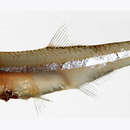Diagnostic Description
provided by Fishbase
Diagnosis: Body somewhat compressed, belly a little rounded, with 0-5 small needle-like pre-pelvic scutes; maxilla tip pointed, reaching to or a little beyond hind border of pre-operculum, the latter convex, rounded; lower gillrakers usually 23 to 28; small teeth present on upper edge of hyoid bones; isthmus muscle tapering evenly forward to hind border of branchial membrane; pelvic fin tips reaching to below anterior dorsal finrays; anal fin short, with usually 3 unbranched and 18-19 branched finrays, its origin below second half of dorsal fin base; body light transparent fleshy brown, with a silver stripe down flank; a pair of dark patches behind occiput, followed by a pair of dark lines to dorsal fin origin (Ref. 189). It closely resembles Stolephorus apiensis of Fiji and Samoa, which lacks pigment lines before the dorsal fin; and S. brachycephalus of Papua New Guinea, which has more anal finrays, no hyoid teeth, and more scutes; Stolephorus waitei has characteristic spots on the lower part of the head, and the pelvic fins do not reach to the dorsal fin origin, as also in S. chinensis; other Stolephorus species have the hind border of the pre-operculum concave near the maxilla tip (Ref. 189).Description: Body somewhat compressed, belly a little rounded (Ref. 189). Snout prominent; maxilla long, reaching to gill opening (Ref. 2871, 30573). Isthmus continuous, no silvery plate (Ref. 2871). Number of gill rakers on upper limb 17-21, on lower limb 23-28 (Ref. 122132). Pelvic-fin tip reaching beyond dorsal-fin origin; anal-fin origin below dorsal-fin base (Ref. 30573). With 0-5 small needle-like pre-pelvic scutes; no post-pelvic scutes (Ref. 189, 30573).Colouration: Body light transparent fleshy brown, with a silver stripe down flank; a pair of dark patches behind occiput, followed by a pair of dark lines to dorsal fin origin (Ref. 189).
- Recorder
- Crispina B. Binohlan
Diseases and Parasites
provided by Fishbase
Hexangium Infestation. Parasitic infestations (protozoa, worms, etc.)
Migration
provided by Fishbase
Anadromous. Fish that ascend rivers to spawn, as salmon and hilsa do. Sub-division of diadromous. Migrations should be cyclical and predictable and cover more than 100 km.
- Recorder
- Crispina B. Binohlan
Morphology
provided by Fishbase
Anal spines: 0; Analsoft rays: 21 - 22
- Recorder
- Crispina B. Binohlan
Trophic Strategy
provided by Fishbase
Apparently entering brackish water; present in Godavari estuary, India, from February to June in salinities of 19.6 to 32.0 o/oo, but almost completely absent during the subsequent flood season (Ref. 189). Juveniles and/or adults are found in mangrove inlets, subtidal edge of mud flats, near inshore and far inshore waters (Ref. 121464).
- Recorder
- Crispina B. Binohlan
Biology
provided by Fishbase
A schooling fish found in coastal waters, apparently entering brackish water (Ref. 189), at depths of 0-50 m (Ref. 82332). Present in Godavari estuary, India, from February to June in salinities of 19.6-32.0 ppt, but almost totally absent in subsequent flood season (Ref. 189). It feeds on surface plankton, primarily copepods and prawn larvae (Ref. 189). Eggs are oval with a knob (Ref. 189). Used for food and fish meal (Ref. 4537).
- Recorder
- Crispina B. Binohlan
Importance
provided by Fishbase
fisheries: commercial
- Recorder
- Crispina B. Binohlan
分布
provided by The Fish Database of Taiwan
廣泛分布於印度-西太平洋區,西起非洲東岸至巴布新幾內亞及中國南方沿海。臺灣產於南部、西部及澎湖海域。
利用
provided by The Fish Database of Taiwan
全年皆產,南部及澎湖沿海較多,是魩鱙漁業的重要漁獲物之一,多以焚寄網捕獲,新鮮時可清蒸,但大多曬乾後出售,炒花生、辣椒或煮湯。
描述
provided by The Fish Database of Taiwan
體長形,腹部圓,僅有1-4枚小稜鱗位於胸鰭與腹鰭間。頭略長。吻鈍圓,突出。眼中大。口大,略下斜;上頜前端突出於下頜,上頜骨末端尖,向後延伸達前鰓蓋骨之後緣;前鰓蓋骨之後緣呈圓凸。鰓耙細長而密,下枝鰓耙在23-28間。體被圓鱗,鱗小而薄,易脫落,無側線。背鰭短,位於體中央,前方無棘狀稜鱗;腹鰭短,末端未達背鰭起點;臀鰭起點位於背鰭中部下方。體灰白色,體側中央由頭部起始至尾柄具一條銀白色帶。各鰭多半透明而略呈青灰色。
棲地
provided by The Fish Database of Taiwan
近沿海表層魚類,多於表層至20公尺深之海域活動。以濾食浮游生物為生。具群游性。
Stolephorus commersonnii
provided by wikipedia EN
Commerson's anchovy (Stolephorus commersonnii), also known as Devis's anchovy, long-jawed anchovy, Teri anchovy, is a species of anadromous ray-finned fish in the family Engraulidae. It is known as haalmassa in Sri Lanka, where it is widely used as a nutrient-rich fish meat. It is widely used as a live or dead bait in tuna fishery.
Description
It is a small schooling fish found in depth of 0–50 m in most of the tropical areas of the Indo-Pacific oceans, including Madagascar and Mauritius eastward and towards Hong Kong and further east to Papua New Guinea in westwards.[1] Maximum standard length is 11.2 cm. It has 21–22 anal soft rays. There are 0–5 small needle-like scutes on the belly region. Belly is slightly rounded. Body color is same as other engraulids, where body is light transparent fleshy brown with a pair of dark patches behind occiput, followed by a pair of lines to dorsal fin origin. The silver stripe is present on flanks.[2]
Ecology
Indian anchovy usually feeds on surface plankton. Female lay oval eggs in grassy sea beds.[2]
Human use
This fish, with the much larger Indian anchovy, is part of the cuisine of the South- and Southeast Asian marine regions.[3] It can be crisp-fried, used to make fish-based culinary products like fish sauce or in curries. In Sri Lanka, this variety of fish is made into a tasty snack by dipping in a batter of flour, then rolled in bread crumbs and deep fried in oil. It is also popular as a ‘white curry’, i.e.a curry made with coconut milk. A spicier variant is made with dry chilli gravy and served with scraped fresh coconut to offset the hotness of the gravy.
Vernacular names
Commerson's anchovy is known as:
See also
References

- license
- cc-by-sa-3.0
- copyright
- Wikipedia authors and editors
Stolephorus commersonnii: Brief Summary
provided by wikipedia EN
Commerson's anchovy (Stolephorus commersonnii), also known as Devis's anchovy, long-jawed anchovy, Teri anchovy, is a species of anadromous ray-finned fish in the family Engraulidae. It is known as haalmassa in Sri Lanka, where it is widely used as a nutrient-rich fish meat. It is widely used as a live or dead bait in tuna fishery.
- license
- cc-by-sa-3.0
- copyright
- Wikipedia authors and editors

